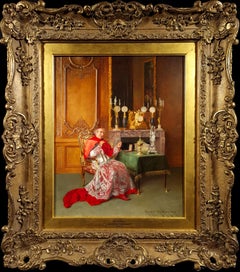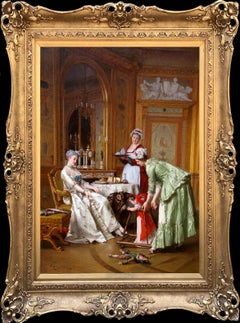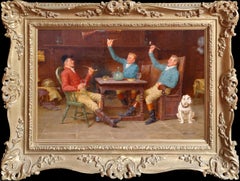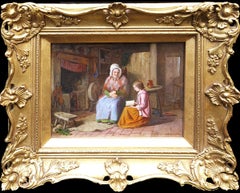Want more images or videos?
Request additional images or videos from the seller
1 of 6
Théophile Emmanuel DuvergerBlowing Bubbles
$70,736.22List Price
About the Item
- Creator:Théophile Emmanuel Duverger (1821 - 1898, French)
- Dimensions:Height: 21.5 in (54.61 cm)Width: 17.25 in (43.82 cm)
- Medium:
- Period:
- Condition:Professionally cleaned and ready to hang.
- Gallery Location:Belgravia, London, GB
- Reference Number:Seller: 75521stDibs: LU136027446192
About the Seller
5.0
Recognized Seller
These prestigious sellers are industry leaders and represent the highest echelon for item quality and design.
Established in 1971
1stDibs seller since 2020
20 sales on 1stDibs
Associations
LAPADA - The Association of Arts & Antiques DealersThe British Antique Dealers' Association
Authenticity Guarantee
In the unlikely event there’s an issue with an item’s authenticity, contact us within 1 year for a full refund. DetailsMoney-Back Guarantee
If your item is not as described, is damaged in transit, or does not arrive, contact us within 7 days for a full refund. Details24-Hour Cancellation
You have a 24-hour grace period in which to reconsider your purchase, with no questions asked.Vetted Professional Sellers
Our world-class sellers must adhere to strict standards for service and quality, maintaining the integrity of our listings.Price-Match Guarantee
If you find that a seller listed the same item for a lower price elsewhere, we’ll match it.Trusted Global Delivery
Our best-in-class carrier network provides specialized shipping options worldwide, including custom delivery.You May Also Like
Moth Finder - Male Couple Embracing, Piercing Blue Eyes, Original Oil Painting
By Bruno Surdo
Located in Chicago, IL
A couple embraces, one looking directly out at the viewer. His piercing blue eyes are enhanced by the dark backdrop. A colorful moth sits upon his fingertips but he seems more enga...
Category
21st Century and Contemporary Contemporary Figurative Paintings
Materials
Oil, Panel
I WOKE UP ASLEEP - Panoramic Oil Painting of a Bathroom Scene From a Dream
Located in Signal Mountain, TN
The interconnectivity between one's waking life and one’s dreams offers a point of convergence between the real and the surreal, the ordinary and the absurd. Daily observations are recycled into nightly visions, and consciousness becomes an in-between state. Experiences turn into memories which turn into dreams which turn into experiences.
This piece appears as part of two-person exhibition with Jason Stout at Channel To Channel...
Category
2010s Contemporary Interior Paintings
Materials
Panel, Oil
$10,400 Sale Price
20% Off
H 24 in W 72 in D 1 in
IKEA (2022), oil on wood panel, coral reef, banana, bright pattern, faux naif
By Max Vesuvius Budnick
Located in Jersey City, NJ
IKEA (2022), oil on wood panel painting by Max Vesuvius Budnick, coral reef and banana, bright pattern, faux naif
Classic faux naif interiors oil painting by Max Vesuvius Budnick. The artist cannot resist painting an appealing pattern and was enamored with this IKEA shower curtain...
Category
2010s Contemporary Interior Paintings
Materials
Wood, Oil, Wood Panel
$2,000
H 20 in W 23 in D 2.5 in
Half Men - Figures Cast in Shadow and Female Nude, Bold Colors, Heavy Paint
Located in Chicago, IL
Two figures, cast in shadows, stand in the foreground between a nude female figure in the background. Loose brushwork, thick with expressive, bold colors and strong contrast in shadows, add to the mystery of this gathering of characters. This artwork is mounted to a wood cradle and can hang directly on the wall. Please contact the gallery for framing options.
Georgia Hinaris...
Category
2010s Contemporary Figurative Paintings
Materials
Oil, Panel
"Coro de monaguillos ensayando", 19th Century Oil on Wood Panel by José Gallegos
By José Gallegos y Arnosa
Located in Madrid, ES
JOSÉ GALLEGOS Y ARNOSA
Spanish, 1857 - 1917
CORO DE MONAGUILLOS ENSAYANDO
signed, located and dated "JGallegos / Roma 1883" (lower right)
oil on...
Category
1880s Realist Figurative Paintings
Materials
Oil, Wood Panel
$20,207
H 16.54 in W 25.6 in
The Canary
By Donald S. Vogel
Located in Dallas, TX
The overall dimensions including the frame are 70 x 42 inches.
Donald Vogel’s paintings reflect his interest in seeking beauty in life and in sharing pleasure with his viewers. Voge...
Category
20th Century American Impressionist Figurative Paintings
Materials
Oil, Panel
"Dancers reading III", Impressionist Indoor scene with tow girls. Oil on panel .
By Iain FAULKNER
Located in Segovia, ES
"Dancers reading III", Impressionist Indoor scene with tow girls. Oil on panel.
Measurements in centimeters: 61 x 61 cm / In inches 24.02 x 24.02 “
Framed: 78 x 78 x 4 cm. / In inches 30.71 x 30.71 x 1.57 "
This artwork, signed IF by Scottish artist Iain Faulkner...
Category
Early 2000s Impressionist Figurative Paintings
Materials
Oil, Panel
$8,463 Sale Price
20% Off
H 30.71 in W 30.71 in D 1.58 in
"Dancers resting VII". Impressionist interior scene with two girls. Oil on panel
By Iain FAULKNER
Located in Segovia, ES
"Dancers resting VII". Impressionist interior scene with two girls. Oil on panel
Measurements in centimeters: 61 x 61 cm / In inches 24.02 x 24.02 “
Framed: 78 x 78 x 4 cm. / In inches 30.71 x 30.71 x 1.57 "
This artwork , signed IF in the left down corner, by the author Iain Faulkner, is a very well studied composition with two dancers, dressed in blue color, lying on a beautiful mosaic floor with gold border, having a rest. The circle design of the mosaic, the figures in three quarters in parallel; opposite the postures, the suits, and the colors blue and flesh. This complementation above and below, and to the left and right of the painting, gives the painting a surprising composition and excellent balance.
Despite the thick brushwork, the author achieves a very subtle effect in the definition of the two beautiful figures and very successful effects of light and shadow.
Iain Faulkner acknowledges the influence on his painting of artists such as Sargent, Degas, Whistler and, especially, Vermeer, showing scenes with figures performing everyday tasks while lost in thought, like this two dancers.
This piece was originaly purchased from Albemarle Gallery in London.
ABOUT THE ARTIST
Born in Glasgow in 1973 and graduating from Glasgow School of Art in 1996 with a BA (Honours) in Fine Art.
His degree show was sell-out.
Iain Faulkner is now one of Britain's top figurative painters, a stablished artist with the Albemarle/Pontone Galleries in London, and with numerous solo shows in New York, Paris, Geneva, Monaco and Bologna .
His work appears in many private and corporate collections and in the Scottish National Portrait Gallery.
In 2010 he was commissioned to paint the European Ryder Cup...
Category
Early 2000s Impressionist Figurative Paintings
Materials
Oil, Panel
$8,463 Sale Price
20% Off
H 30.71 in W 30.71 in D 1.58 in
Bloody Birthday - Female Nude, Bold Colors and Heavy Textured Paint on Panel
Located in Chicago, IL
A female nude dances in a private moment yet the figure in the background seems to be watching. The figure's face is obscured adding to the intrigue of the subject. Loose brushwork, thick with expressive, bold colors and strong contrast in shadows, add to the overall aesthetic. Georgia Hinaris...
Category
2010s Contemporary Figurative Paintings
Materials
Oil, Panel
The Musical Performance oil on panel by Antonio Ermolao Paoletti
Located in New York, NY
The Musical Performance by Antonio Ermolao Paoletti
An italian genre painting showcasing two boys playing a trumpet and a guitar for their sist...
Category
19th Century Academic Figurative Paintings
Materials
Oil, Wood Panel, Board
$23,600
H 22.5 in W 34 in
More From This Seller
View AllPresentation
By Georges Croegaert
Located in Belgravia, London, London
Presentation
by Georges Croegaert
French born 1848 – 1923
Oil on panel
Panel size: 16 x 13 inches
Framed size: 24.25 x 21.25 inches
Signed
Category
19th Century Figurative Paintings
Materials
Oil, Panel
Her First Steps
Located in Belgravia, London, London
Oil on panel
Panel size: 26.5 x 19.5 inches
Framed size: 35 x 28 inches
Signed and dated 1878 lower left
Category
19th Century Figurative Paintings
Materials
Oil, Panel
A Hearty Praise
By John Arthur Lomax
Located in Belgravia, London, London
Oil on panel
Panel size: 11.75 x 18 inches
Signed lower right
Category
19th Century Figurative Paintings
Materials
Oil, Panel
Reading to Grandma
By James Hardy Jr.
Located in Belgravia, London, London
Oil on panel
Panel size: 6 x 8 inches
Framed size: 10.25 x 12.25 inches
Signed and date '1860' lower right
Category
19th Century Figurative Paintings
Materials
Oil, Panel
Furry Friends (Pair)
Located in Belgravia, London, London
Oil on panel
Panel size: 4.75 x 6 inches each
Framed size: 9.25 x 11 inches each
Monogrammed and dates '66
Category
19th Century Figurative Paintings
Materials
Oil, Panel
Drake's Tales of Treachery
By Arthur David McCormick
Located in Belgravia, London, London
Oil on canvas
Canvas size: 20 x 30 inches
Framed size: 28 x 36 inches
Signed lower right
Category
19th Century Figurative Paintings
Materials
Canvas, Oil
Recently Viewed
View AllMore Ways To Browse
Blowing Bubbles
Antique Bubble Frames
Theophile Emmanuel Duverger
Painted Rolex
Painting Toreador
Paintings By Peruvian Artists
Paintings Of Wolves
Peter J Greenhill
Philippe De Champaigne
Polynesian Painting
Portrait Of An Actor
Prison Window
Rabbis Dancing
Ranulph Bye
Reggianini Vittorio
Rogier Van Der Weyden
Rolex Painting
Ron Childers



